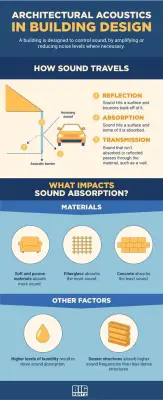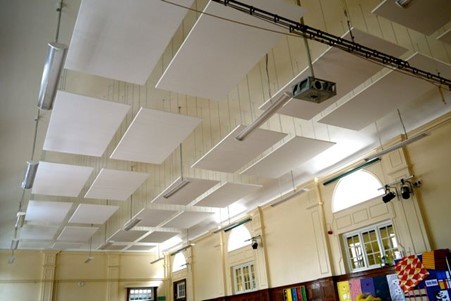How soundproofing elevates architectural design, Building sound limiting tips, Partition best practice
How Soundproofing Elevates Architectural Design
28 Aug 2023
Introduction – Soundproofing elevates architectural designs
In the architectural world, acoustic comfort often takes a backseat, despite having a profound impact on physical and mental health. However, the trend of integrating soundproofing strategies in design planning is an attempt to rectify this oversight.
Overview of soundproofing in architectural design
Soundproofing is a strategic design method that aims to control the penetration of noise within built spaces effectively. It deploys materials or techniques to absorb, reflect or isolate sound waves. The importance of soundproofing goes beyond providing a quiet environment. It enhances user satisfaction, productivity, and wellbeing. Moreover, it also contributes to improving overall architectural aesthetics.
Thus, with careful consideration of soundproofing during design planning, architects can create functional, comfortable and aesthetically pleasing spaces. The fusion of excellent acoustic performance and architectural beauty proves that form and function can coexist harmoniously.

Source: acropolis-wp-content-uploads.s3.us-west-1.amazonaws.com
Importance of Soundproofing in Architectural Design
Benefits of soundproofing in creating an ideal environment
Soundproofing is a critical element in architectural design that often goes unnoticed but plays a vital role in creating a comfortable and functional space. It involves incorporating materials and techniques to reduce or eliminate unwanted noise from entering or exiting a building. This article will highlight some key benefits of soundproofing in architectural design.
- Enhanced Privacy: Soundproofing helps maintain confidentiality and privacy by preventing sound from travelling between rooms or areas. Whether it’s an office space, hotel room, or residential property, soundproofing ensures that sensitive conversations or activities remain private and undisturbed.
- Improved Concentration: Unwanted noise can be a major distraction, especially in work environments. By implementing soundproofing measures, such as acoustic panels or double-glazed windows, the impact of external noises like traffic or construction can be minimised, allowing occupants to focus better and be more productive.
- Increased Comfort: Soundproofing reduces the transmission of noise, creating a quieter and more peaceful atmosphere. This is particularly important in residential buildings, hotels, or healthcare facilities where a calm environment is essential for relaxation, recovery, and overall well-being.
- Enhanced Audio Experience: Soundproofing can significantly improve the audio quality within a space. Whether it’s a concert hall, recording studio, or home theatre, soundproofing techniques help in optimising acoustics and preventing sound distortion, resulting in a more immersive and enjoyable audio experience.
- Compliance with Regulations: Many municipalities have regulations regarding noise control and sound insulation standards for buildings. By incorporating soundproofing measures into architectural design, professionals ensure compliance with these regulations and mitigate any potential legal or operational issues.
In conclusion, soundproofing is an essential aspect of architectural design to create a harmonious and functional space. The benefits of soundproofing include enhanced privacy, improved concentration, increased comfort, enhanced audio experience, and compliance with regulations. By prioritising soundproofing in architectural projects, professionals can enhance the overall quality and usability of the built environment
Soundproofing Materials and Techniques
When it comes to architectural design, one crucial factor that often gets overlooked is soundproofing. However, incorporating proper soundproofing techniques can elevate the overall experience and functionality of a space.
Different types of materials and techniques used for soundproofing
- Acoustic Insulation: Installing insulation materials, such as mineral wool or fibreglass batts, can effectively absorb sound vibrations and reduce noise transmission between rooms or from the exterior.
- Decoupling: This technique involves creating a separation between surfaces to minimise sound transmission. Installing resilient channels or rubber isolators between walls, floors, or ceilings helps prevent vibrations from transferring through the structure.
- Mass-Loaded Vinyl: Adding mass-loaded vinyl sheets to walls or ceilings can significantly reduce airborne noise. This flexible material effectively blocks sound waves and improves soundproofing performance.
- Sealing and Caulking: Properly sealing gaps, cracks, and joints can prevent sound leakage. Using acoustic sealants or caulk helps create an airtight barrier, ensuring maximum sound isolation.
- Double Glazing: Installing double-glazed windows with an air gap in between enhances sound insulation by providing an additional layer of separation from external noise sources.
By incorporating these materials and techniques into architectural design, spaces can become more comfortable, private, and conducive to specific activities. Whether it’s a residential area, office space, or commercial building, soundproofing plays a vital role in enhancing the overall quality of the environment.
Acoustic Design Principles
Understanding the principles of acoustic design in architectural spaces
Creating a visually stunning and functional architectural design is essential, but have you considered the impact of sound on the overall experience? Soundproofing is a crucial element that can elevate the quality of architectural spaces.
When it comes to architectural design, acoustics play a significant role in optimising the functionality and comfort of a space. Here are some key principles to consider:
- Noise Control: Effective soundproofing techniques can minimise noise pollution from external sources or neighbouring spaces. By reducing unwanted external sounds, you can create a serene environment that enhances productivity and relaxation.
- Speech Intelligibility: A well-designed space should ensure clear communication. By addressing reverberation and echo, acoustic design can enhance speech intelligibility, making it easier for people to understand one another in crowded areas.
- Ambience Creation: Acoustic design influences the ambience of a space. By controlling the level and quality of sound reflections, you can create an atmosphere that suits the purpose and mood of the environment, whether it be lively and energetic or calm and peaceful.
- Privacy Enhancement: Soundproofing measures can provide privacy in areas where confidentiality is crucial, such as offices, meeting rooms, or healthcare facilities. By preventing sound leakage, you can ensure confidential conversations remain private.
By understanding and implementing these principles of acoustic design, architects and designers can create spaces that not only please the eye but also elevate the overall experience through optimised sound quality and comfort.
Soundproofing in Residential Buildings
Implementing soundproofing measures in homes and apartments
Soundproofing has become an essential aspect of modern architectural design in residential buildings. With the increasing urbanisation and population density, the need for quiet and peaceful living spaces is more evident than ever.
Architects and designers are incorporating various soundproofing measures to minimise noise transmission within buildings. This includes using materials that absorb or dampen noise, such as acoustic panels, double-glazed windows, and sound-blocking doors. Additionally, proper insulation and sealing of wall cavities can help prevent sound leakage.
By implementing soundproofing measures, residential buildings can provide occupants with a serene living environment, free from the disturbances caused by external noise sources or neighbouring units. From reducing traffic noise to minimising noise between connected units, soundproofing enhances the overall comfort and quality of life for residents.
Moreover, soundproofing is not limited to just individual apartments or houses. It can also be applied to common areas, such as hallways, gyms, or communal spaces, ensuring that residents have a peaceful experience throughout the entire building.
In conclusion, soundproofing has become an integral part of architectural design in residential buildings. By implementing effective measures to minimise noise transmission, architects and designers are creating spaces that prioritise tranquillity and well-being for occupants.
Soundproofing in Commercial Buildings
Soundproofing is an essential aspect of architectural design, especially in commercial buildings. It involves the implementation of various techniques and materials to reduce or eliminate unwanted noise and create a comfortable environment for occupants.
Application of soundproofing techniques in offices, hotels, and public spaces
In offices, soundproofing can enhance productivity by reducing distractions from outside noise or neighbouring workspaces. Acoustic panels, sound-absorbing materials, and double glazing in Ayrshire are commonly used to achieve this.
Hotels also benefit from soundproofing as it ensures a peaceful atmosphere for guests. Strategies like using solid core doors, acoustic insulation, and noise-isolating partitions can create a tranquil environment, enhancing customer satisfaction.
Public spaces such as conference halls, theatres, and libraries require effective soundproofing to provide optimal acoustic experiences. Specialised sound barriers, acoustic ceiling tiles, and carpet flooring can be employed to minimise reverberation and improve clarity of sound.
Implementing soundproofing techniques not only enhances the overall architectural design but also contributes to the well-being and comfort of occupants. By considering these techniques during the design process, architects can create spaces that offer privacy, tranquillity, and an immersive experience for everyone.

Source: www.mutesoundproofing.com
Soundproofing in Educational Institutions
Creating optimal acoustics in schools, colleges, and universities
When it comes to architectural design in educational institutions, soundproofing plays a crucial role in enhancing the learning experience. A well-designed space with optimal acoustics can make a significant difference in students’ ability to concentrate and comprehend information.
By incorporating soundproofing materials and techniques into classrooms, lecture halls, and libraries, educational institutions can create a quieter and more focused environment. This helps to reduce distractions from external noises, such as footsteps or traffic, as well as internal noise from neighbouring classrooms or common areas.
In addition to improving concentration levels, soundproofing also promotes better communication and engagement among students and teachers. Clear and uninterrupted audio enhances the effectiveness of lectures, presentations, and group discussions, enabling students to participate actively and grasp concepts more easily.
Furthermore, creating optimal acoustic conditions contributes to the overall aesthetics and functionality of educational spaces. It ensures that the architecture blends harmoniously with its purpose by minimising sound reverberation and echo, providing a comfortable environment for both students and faculty.
In conclusion, incorporating soundproofing measures into educational institutions elevates their architectural design by enhancing the learning experience. By reducing distractions and improving communication, these institutions create an environment conducive to focused learning and efficient knowledge transfer.
Innovative Soundproofing Solutions
Exploring advanced technologies and innovative approaches to soundproofing
In the world of architectural design, creating spaces that are not only aesthetically pleasing but functional as well is paramount. One key factor that often gets overlooked is soundproofing. With the rise in urbanisation and open-concept layouts, noise pollution has become a major concern. Fortunately, there are a plethora of innovative solutions available to elevate architectural design and create acoustically efficient spaces.
Advanced technologies like soundproof glass windows, acoustic wall panels, and suspended ceilings provide effective noise reduction without compromising on style. These materials and techniques can be seamlessly integrated into any design concept, offering both practicality and visual appeal.
Additionally, incorporating sound-absorbing materials such as cork, fabric-covered acoustic panels, and soft flooring materials can greatly enhance the overall acoustics of a space. These elements work to absorb and reduce reverberation, echoes, and unwanted noise, resulting in a more comfortable environment for occupants.
Architects and designers are also exploring innovative approaches like utilising sound-masking systems and strategic room layout planning. These techniques aim to create a balanced acoustic environment by introducing low-level background noise that disguises disturbances and promotes privacy.
By prioritising soundproofing in architectural design, professionals can improve the quality of spaces and enhance the user experience. Whether it’s an office space, a hotel lobby, or a residential building, implementing these advanced soundproofing solutions ensures that every occupant can enjoy a peaceful and serene environment.
Impact of soundproofing on architectural design
The impact of soundproofing on architectural design and recommendations for implementing effective soundproofing measures:
Soundproofing plays a crucial role in elevating architectural design by ensuring a peaceful and comfortable environment for building occupants. It helps to minimise unwanted noise from external sources, neighbouring spaces, or mechanical systems within the building. Here are a few key reasons why soundproofing is important in architectural design:
- Enhanced User Experience: Soundproofing helps create tranquil spaces where people can work, relax, or interact without being disturbed by external noises. This improves the overall user experience and promotes productivity, concentration, and well-being.
- Privacy: Soundproofing is essential in environments where privacy is crucial, such as healthcare facilities, offices, or hotels. It prevents conversations or activities from being overheard, ensuring confidentiality and comfort for individuals.
- Aesthetics: Effective soundproofing solutions can seamlessly integrate into the architectural design, maintaining the desired aesthetics while providing acoustic insulation. This allows architects and designers to create visually appealing spaces without compromising on acoustic comfort.
To implement effective soundproofing measures in architectural design, consider these recommendations:
- Building Layout: Optimise the layout to minimise sound transmission between different areas within the building. Place noise-sensitive areas away from potentially noisy spaces and use buffer zones or absorptive materials to reduce sound transfer.
- Materials and Construction: Select materials with high sound transmission class (STC) ratings that absorb or block sound effectively. Incorporate double-glazed windows, insulation materials, and sound-absorbing panels for effective noise control.
- Mechanical Systems: Properly design HVAC systems to reduce noise transmission through ductwork or equipment vibrations. Ensure proper insulation and strategic placement of mechanical components to minimise noise impact.
In conclusion, soundproofing is essential in architectural design to create peaceful, functional, and aesthetically pleasing spaces. By implementing effective soundproofing measures, architects can enhance user experience, provide privacy, and achieve acoustic comfort in various building environments.
Comments on the How Soundproofing Elevates Architectural Design article welcome.
Glasgow Architecture
Major Strathclyde Building Designs – selection:
Historic Glasgow : best Glasgow architecture of the past
Comments / photos for the How Soundproofing Elevates Architectural Design page welcome



